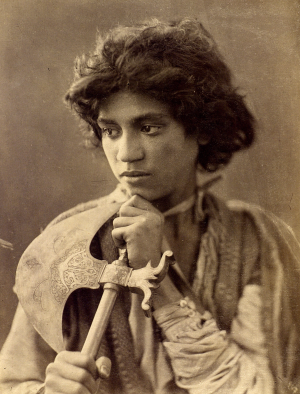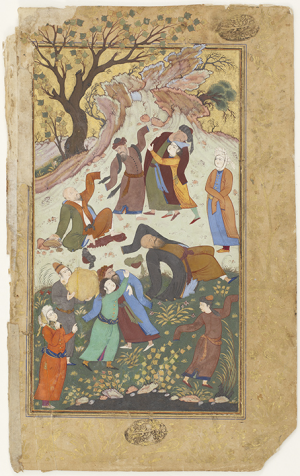(Boylove Documentary Sourcebook) - The Medieval Persian Sufi Ritual Practice of "Shāhid-Bāzī", the Mystical Contemplation of Handsome Beardless Youths, as Featured in Two Anecdotes from the Anonymous Hagiography of Fakhr al-Dīn ʿIrāqī

From "Embodying the beloved: embodiment, (homo)eroticism, and the straightening of desire in the hagiographic tradition of Fakhr al-Dīn ʿIrāqī" by Matthew Thomas Miller, in Middle Eastern Literatures, Vol. 21, No. 1 (2018). Footnotes omitted.
Note 1: The anonymous hagiography quoted in the excerpt below is titled "Muqaddimah-yi dīvān" (c. 1289–1453). It was published in Kulliyyāt-i Shaykh Fakhr al-Dīn Ibrāhīm Hamadānī mutakhallaṣ bi-ʿIrāqī, edited by Saʿīd Nafīsī (Tihrān [Tehran]: Kitāb-Khānah-yi Sanāʾī, 1362 [1983]).[1][2]
Note 2: The term shāhid-bāzī means literally "witness play", referring to the contemplation of supernatural beauty in earthly forms, but also has the sense of "love of boys".[3][4]
The thirteenth-century Persian Sufi poet, Fakhr al-Dīn ʿIrāqī (d. 688/1289), was famous for many things: he was a great poet, the author of one of the most important treatises on Sufi love theory (i.e. Lamaʿāt), and undoubtedly, one of the most profligate practitioners of Sufi ritual “love play” (ʿishq-bāzī). This last point is reflected well in his hagiography, which contains more than a half dozen anecdotes of him engaging in different forms of ʿishq-bāzī with various earthly beloveds all of the way from India to Anatolia. It is, in fact, his predilection for falling in love with earthly beauties that led to his initial conversion to a particular antinomian mode of Sufism championed by figures known as the “qalandars.” In what is surely one of the most emblematic stories of Sufi (homo)eroticism in medieval Persian literature, ʿIrāqī’s anonymous hagiography reports that one day as young ʿIrāqī is teaching the traditional Islamic sciences in a madrasa in his hometown of Hamadān, a wild band of qalandars rushes into his assembly, disturbing not only the day’s lesson and the orderly piety of its congregants but indeed the very core of ʿIrāqī’s being.
Suddenly a group of qalandars arrived and entered the assembly with all their merry commotion. They began to do samāʿ and sing a ghazal ... When the qalandars had finished their song and recited their ghazal, ʿIrāqī was seized by an internal turmoil. Amongst the qalandars he saw a boy (pisar) who was without peer in beauty and was desirable to the heart of lovers. A beauty such that if a Chinese painter saw his waving ringlet, he would have been bewildered. He saw that royal falcon again and the bird of his heart fell in the trap of love and the fire of loving desire burnt up his rationality. He took off his garments and turban, and gave them to the qalandars, and recited this ghazal:
How wonderful it would be if you were my sweetheart!
My intimate friend, companion, and beloved (yār)
The whole world could not contain me in this joyful state
if for but one moment you would be my bosom buddyAfter a time had passed, the qalandars left Hamadān and set out towards Iṣfahan. When they were gone, ʿIrāqī was overtaken with yearning and his state of being was transformed. He threw away his books [he goes on to list many famous books of traditional Islamic learning] ... the master of the sciences became a madman ... and he set out on the road towards his friends. After he went two miles on the path, he reached them and recited this ghazal:
O boy! Play the qalandar tune if you are our mate
for I have seen that the end of the lane of piety is far
[...]
The anonymous introduction and most hagiographies of ʿIrāqī after it are clear on the primary impetus behind ʿIrāqī’s internal transformation.
[...]
If any ambiguity remains on this point, the author dispels it later informing us that ʿIrāqī spent all his time loving the boy (bā ʿishq-i pisar bih sar hamī burd) before their fateful separation in a large storm on their trip from Delhi to Somnath.
[...]
The figure of the beautiful qalandari youth in ʿIrāqī’s hagiography is simultaneously a stock figure and the most powerful character in the narrative. Although highly stylized like the beloved of the medieval Persian lyric, he is the locus of the poet’s desire and a catalyst for all sorts of dramatic transformations in ʿIrāqī’s behavior. It is his beauty that sets fire to ʿIrāqī’s heart and catapults him beyond the territorial and spiritual confines of his local madrasa and mosque. While ʿIrāqī’s predisposition to fall in love is a necessary precondition, it is the sight of the youth that first “disturbs” ʿIrāqī-the-Traditional-Pious-Muslim and then transforms him into a heedless lover on the rogue’s path. In this respect, the youth in the above story is a functional character, playing a well-established role in Persian Sufi literature: he is the so-called “metaphoric” (majāzī) “trainer beloved” for the young spiritual novice. In this capacity, he will help mature ʿIrāqī’s love into a higher divine form. The young qalandar fulfills his duty well, as we subsequently learn. He leads ʿIrāqī all of the way to India, where he eventually becomes a disciple of the great Sufi master Bahāʾ al-Dīn Zakariyyā of Multān. Under the direction of this capable master, ʿIrāqī attains to the highest levels of divine love—in no small part due to the erotic training he received during his time as lover of his first beloved, the qalandar youth.
[...]
Returning to the accounts of the anonymous biographer and Jāmī, the next major event in ʿIrāqī’s life is his departure for Cairo. As was the case when he departed from Multān, he is forced to leave his Sufi lodge in Tūqāt due to political circumstances. The Mongols execute his patron, Amīr Parvānah, on the suspicion that he had aided the Mamluks in their invasion of Anatolia, and ʿIrāqī comes under suspicion by association. He flees to Cairo, where he attempts to free Parvānah’s son who has been imprisoned there by the Mamluks. This endeavor brings him into contact with the sultan of Cairo. After a series of impressive exhibitions of his spiritual status and moral probity, the sultan of Cairo grows so impressed with ʿIrāqī that he gives him a daily allowance and names him the chief shaykh of Cairo. ʿIrāqī is back on top of the world after losing his Sufi lodge, and nearly his life, just weeks earlier due to his connection to the suspected traitor Amīr Parvānah.
However, events quickly take a turn for the worse once again. “Friends” of the sultan inform him that ʿIrāqī has taken a particular liking to the beautiful son of a local cobbler in the Cairo market:
One day ʿIrāqī was passing through the shoe market and his gaze fell upon a boy (pisar) and he became enamored with him. He went to him and said hello and asked the cobbler: Whose boy is this? The cobbler said: He is my boy. The shaykh stretched out his hand and grabbed the lips of the boy and replied: Is it not oppression that a mouth, lips, and teeth such as these are the companion of leather? The cobbler replied: We are poor people and our craft is this. If his teeth do not tear leather, then they won’t eat bread. The shaykh asked him: How much does this boy earn per day? He replied: Four dirhams per day. The shaykh ordered: I will give him eight dirhams per day and he must not do work like this anymore. Everyday the shaykh would go with his friends and sit in the shop and gaze at him without a care in the world, recite poetry, and cry.
[...]
The way the anonymous author—followed almost verbatim by Jāmī—develops the remainder of the anecdote illustrates clearly the cause of the anxiety that has haunted this and similar stories of ʿIrāqī’s erotic spiritual practices throughout the hagiography. The sultan, in his interrogation of the “accusers,” is concerned with ascertaining one fact and one fact alone.
The accusers conveyed this news to the sultan [i.e. news of ʿIrāqī practice of shāhid-bāzī with the cobbler’s son]. He responded by asking them: Does he take this boy with him at night, or not? They replied: No. He asked: Does he take this boy into private quarters in the shop? They replied: No. He then requested an ink pot and pen and wrote: Give the servants of shaykh ʿIrāqī five additional dinars per day beyond the allotted amount. He sent it to the royal registrar’s office (dīvān) so they would note it in the royal records. The king’s companions thought that it was a dismissal letter. When its contents were revealed, they lost hope and did not have any other opportunities to impugn ʿIrāqī’s character.

References
- ↑ Matthew Thomas Miller, "Embodying the beloved: embodiment, (homo)eroticism, and the straightening of desire in the hagiographic tradition of Fakhr al-Dīn ʿIrāqī", in Middle Eastern Literatures, Vol. 21, No. 1 (2018), p. 24.
- ↑ Fakhruddin 'Iraqi: Divine Flashes, trans. William C. Chittick and Peter Lamborn Wilson, Classics of Western Spirituality (New York; Mahwah, New Jersey: Paulist Press, 1982), p. 62.
- ↑ Jim Wafer, "Vision and Passion: The Symbolism of Male Love in Islamic Mystical Literature"; Stephen O. Murray and Will Roscoe, eds., Islamic Homosexualities: Culture, History, and Literature (New York; London: New York University Press, 1997), p. 117.
- ↑ Richard Todd, The Sufi Doctrine of Man: Ṣadr al-Dīn al-Qūnawī's Metaphysical Anthropology (Leiden, Netherlands; Boston: Brill, 2014) p. 16.
See also
- Adult friend (dictionary)
- Age of attraction (dictionary)
- Boylove
- Ephebophilia
- Ghilman
- Loved boy (dictionary)
- Minor-attracted person (dictionary)
- Pedophilia
- Young friend (dictionary)